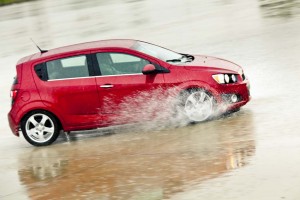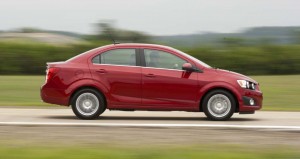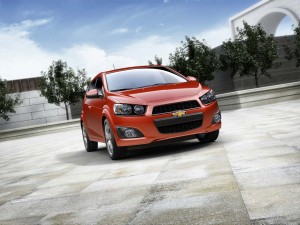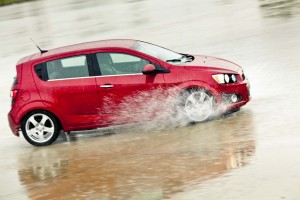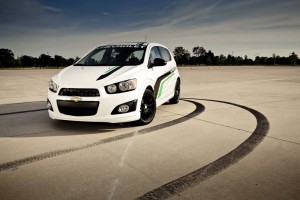
The 2012 Chevrolet Sonic Z-Spec package will add graphics packages, wheels, ground effects and mirror caps to the stock Sonic hatchback.
When it comes to small cars, let’s face it, Detroit has had a history of rolling out some pretty forgettable products, nowhere more so than at Chevrolet, which has dumped on a trusting public such unremarkable and sometimes crude offerings as the Nova, Storm, Cavalier, Cobalt and Aveo.
Which is a good reason why General Motors’ largest division decided to abandon the latter nameplate when it came time to launch an all-new subcompact — one that finally gives reason to Buy American even if there’s more on your mind than a rock bottom price tag.
Yes, the 2012 Chevrolet Sonic does still sport a pleasantly affordable bottom line but the fact is it’s also a reasonably fun car to drive – and one that delivers a surprising amount of features and value for the money.
Sonic is the new name chosen for the replacement for Chevy’s B-segment car. And starting fresh makes sense. Get rid of the old, dated design and uncompetitive engineering – and move production over to the U.S. The outgoing Aveo was assembled in South Korea by what used to be known as Daewoo. While the Koreans, now part of GM’s global product empire, played a critical role in engineering the 2012 Sonic, the new car is being assembled at a plant in suburban Detroit.
We got our chance to take the new Chevy subcompact out on the road during a blustery autumn day near Hell, Michigan – an ironic name for a place that provides some of the best roads in the state for testing out a car’s mettle.
Our choice was to focus on the 5-door as hatchback designs are once again the rage in the American small car segment after years of being largely ignored by U.S. buyers. And with good reason considering some of the horrible examples of years past. But our initial inspection of the 2012 Chevrolet Sonic found a car that was reasonably stylish – if not up to the eye-catching sheet metal of the new Ford Focus – and well fitted together.
The car’s front end is a bit generic, with the oversized headlamps flowing into the fenders resembling so many other recent compact and subcompact offerings. But the wedge-like side profile gives a hint of what one discovers if they’ve also opted – as we did – for the 1.4-liter inline-four powertrain. This turbocharged, 16-valve engine makes some solid numbers, at 138 horsepower and 148 lb-ft of torque coming in 18 and 26, respectively, better than the new Focus.
We did not have access to the 6-speed automatic but did find the 6-speed stick an impressively quick and easy alternative that more buyers should consider, especially if they want to boost both mileage and performance with one package. Despite its sporty nature, a driver should expect to come close to the EPA-rated 40 mpg Highway and 29 City as long as they don’t spend too much time in turbo boost.
There’s also a naturally-aspirated 1.8-liter inline-four making 138 hp and 125 lb-ft. The difference in performance is notable, both on launch and in passing maneuvers, and you’ll eventually offset the lower cost of this engine by spending more on fuel, mileage dropping to 25/39.
We found the new Sonic quick and eager to obey your right foot’s commands for the most part. The stick makes easy to run through the gears – which you’ll need to if you want to execute a pass when you’re in 5th or 6th, gears clearly intended to put the new Chevy in the 40 Mile a Gallon Club.
The steering is a bit numb if nonetheless responsive. None of that soft and sloppy road feel from small Chevys of the past.
Our route included a couple of appropriately hellacious stretches of road that challenge even the most refined cars. Our biggest complaint was a fair amount of head toss and jolting on those stretches. Talking with product engineering chief Jim Federico we learned that the target was a firm ride with the 1.4-liter turbo package. The 1.8 offers a bit softer ride.
What we didn’t experience was any significant slip or slide, no small matter considering how wet the roads were and the fact that we were driving nearly as hard as if they were dry. The suspension and tire package is a definite improvement from any GM small car we’ve seen before.
The seating, meanwhile, was also reasonably impressive, keeping us planted in our seats even on the roughest pavement and while charging the sharpest turns. The downside is that it is a serious hassle to reach all the seat controls. You have to make a contortionist’s twist, wedging your hand uncomfortably, to reach the recliner.
The Sonic is no econobox. As we mentioned earlier, it delivers features you wouldn’t expect in its class – like standard aluminum wheels. The interior, meanwhile, is finished nicely, with a refined use of colors and grains, though you still come away recognizing just how much plastic surrounds you.
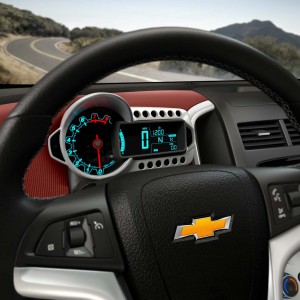
The high-tech gauge cluster underscores Chevy's effort to put some refinement into an interior that could have been chintzy and cheap.
One of the neatest details is a motorcycle-like gauge cluster.
The front seats are roomy, the rear cramped but acceptable if you’re carting kids — or don’t have far to go. The hatchback delivers plenty of cargo space, 19 cubic feet expanding to 37 with the rear seats down. Even the sedan offers plenty of carrying capacity, a segment-leading 15 cf.
For such a small car the 2012 Chevrolet Sonic proved a surprisingly peppy, fun-to-drive choice. It’s roomy and well-outfitted with features and finishes you wouldn’t expect in the segment – all the more impressive considering the $14,995 base price for the LS Sedan, the $15,395 entry into the hatch and the $17,995 for a loaded the LTZ hatchback. At another $700, the turbo is particularly worthy of consideration.
While the Chevy Sonic doesn’t offer quite the style of the Ford Focus – nor quite the level of handling refinement – it is a worthwhile competitor. And it wouldn’t be fair to limit your comparison to what’s offered in Detroit showrooms. The new GM is a viable competitor in a crowded segment and finally puts Chevy into the subcompact game.

